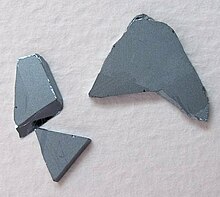Indium arsenide
| Crystal structure | |||||||||||||||||||
|---|---|---|---|---|---|---|---|---|---|---|---|---|---|---|---|---|---|---|---|

|
|||||||||||||||||||
| __ In 3+ __ As 3− | |||||||||||||||||||
| General | |||||||||||||||||||
| Surname | Indium arsenide | ||||||||||||||||||
| other names |
Indium (III) arsenide |
||||||||||||||||||
| Ratio formula | InAs | ||||||||||||||||||
| Brief description |
gray, odorless solid |
||||||||||||||||||
| External identifiers / databases | |||||||||||||||||||
|
|||||||||||||||||||
| properties | |||||||||||||||||||
| Molar mass | 189.74 g mol −1 | ||||||||||||||||||
| Physical state |
firmly |
||||||||||||||||||
| density |
5.68 g cm −3 |
||||||||||||||||||
| Melting point |
936 ° C |
||||||||||||||||||
| solubility |
almost insoluble in water |
||||||||||||||||||
| safety instructions | |||||||||||||||||||
|
|||||||||||||||||||
| Thermodynamic properties | |||||||||||||||||||
| ΔH f 0 |
−58.6 kJ / mol |
||||||||||||||||||
| As far as possible and customary, SI units are used. Unless otherwise noted, the data given apply to standard conditions . | |||||||||||||||||||
Indium arsenide is a chemical compound of indium and arsenic . It is a semiconductor and is one of the III-V semiconductors .
Extraction and presentation
Indium arsenide is formed from the elements at high temperatures :
properties
Indium arsenide crystallizes in the sphalerite structure: arsenide forms a cubic closest packing of spheres and indium occupies half of the tetrahedral gaps . The band gap of the semiconductor is 0.35 eV.
use
Like other III-V semiconductors , indium arsenide is used in the semiconductor industry. It is used for photodiodes in detectors for infrared radiation . Another area of application is laser diodes .
safety instructions
Indium arsenide is toxic and carcinogenic due to the arsenic it contains .
Individual evidence
- ↑ a b c d e data sheet Indium arsenide, 99.9999% (metals basis) from AlfaAesar, accessed on December 7, 2019 ( PDF )(JavaScript required) .
- ↑ Ioffe institute data archive / Basisdaten InAs
- ↑ Not explicitly listed in Regulation (EC) No. 1272/2008 (CLP) , but with the specified labeling it falls under the group entry arsenic compounds, with the exception of those named in this appendix in the Classification and Labeling Inventory of the European Chemicals Agency (ECHA) on February 1, 2016. Manufacturers or distributors can expand the harmonized classification and labeling .
- ↑ David R. Lide (Ed.): CRC Handbook of Chemistry and Physics . 90th edition. (Internet version: 2010), CRC Press / Taylor and Francis, Boca Raton, FL, Standard Thermodynamic Properties of Chemical Substances, pp. 5-5.
- ↑ Basics and main group elements . Walter de Gruyter GmbH & Co KG, 2016, ISBN 978-3-11-049340-5 ( limited preview in the Google book search).
literature
- AF Holleman , E. Wiberg , N. Wiberg : Textbook of Inorganic Chemistry . 102nd edition. Walter de Gruyter, Berlin 2007, ISBN 978-3-11-017770-1 .



